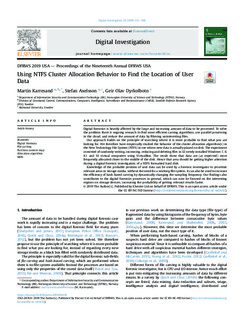| dc.contributor.author | Karresand, Nils Martin Mikael | |
| dc.contributor.author | Axelsson, Stefan | |
| dc.contributor.author | Dyrkolbotn, Geir Olav | |
| dc.date.accessioned | 2019-12-04T12:23:58Z | |
| dc.date.available | 2019-12-04T12:23:58Z | |
| dc.date.created | 2019-10-01T08:42:46Z | |
| dc.date.issued | 2019 | |
| dc.identifier.citation | Digital Investigation. The International Journal of Digital Forensics and Incident Response. 2019, 29 S51-S60. | nb_NO |
| dc.identifier.issn | 1742-2876 | |
| dc.identifier.uri | http://hdl.handle.net/11250/2631756 | |
| dc.description.abstract | Digital forensics is heavily affected by the large and increasing amount of data to be processed. To solve the problem there is ongoing research to find more efficient carving algorithms, use parallel processing in the cloud, and reduce the amount of data by filtering uninteresting files.
Our approach builds on the principle of searching where it is more probable to find what you are looking for. We therefore have empirically studied the behavior of the cluster allocation algorithm(s) in the New Technology File System (NTFS) to see where new data is actually placed on disk. The experiment consisted of randomly writing, increasing, reducing and deleting files in 32 newly installed Windows 7, 8, 8.1 and 10 virtual computers using VirtualBox. The result show that data are (as expected) more frequently allocated closer to the middle of the disk. Hence that area should be getting higher attention during a digital forensic investigation of a NTFS formatted hard disk.
Knowledge of the probable position of user data can be used by a forensic investigator to prioritize relevant areas in storage media, without the need for a working file system. It can also be used to increase the efficiency of hash-based carving by dynamically changing the sampling frequency. Our findings also contributes to the digital forensics processes in general, which can now be focused on the interesting regions on storage devices, increasing the probability of getting relevant results faster. | nb_NO |
| dc.language.iso | eng | nb_NO |
| dc.publisher | Elsevier | nb_NO |
| dc.rights | Attribution-NonCommercial-NoDerivatives 4.0 Internasjonal | * |
| dc.rights.uri | http://creativecommons.org/licenses/by-nc-nd/4.0/deed.no | * |
| dc.title | Using NTFS cluster allocation behavior to find the location of user data | nb_NO |
| dc.type | Journal article | nb_NO |
| dc.type | Peer reviewed | nb_NO |
| dc.description.version | publishedVersion | nb_NO |
| dc.source.pagenumber | S51-S60 | nb_NO |
| dc.source.volume | 29 | nb_NO |
| dc.source.journal | Digital Investigation. The International Journal of Digital Forensics and Incident Response | nb_NO |
| dc.identifier.doi | 10.1016/j.diin.2019.04.018 | |
| dc.identifier.cristin | 1732060 | |
| dc.relation.project | Norges forskningsråd: ArsForensica 248094 | nb_NO |
| dc.description.localcode | © 2019 The Author(s). Published by Elsevier Ltd on behalf of DFRWS. This is an open access article under the CC BY-NC-ND license (http://creativecommons.org/licenses/by-nc-nd/4.0/). | nb_NO |
| cristin.unitcode | 194,63,30,0 | |
| cristin.unitname | Institutt for informasjonssikkerhet og kommunikasjonsteknologi | |
| cristin.ispublished | true | |
| cristin.fulltext | original | |
| cristin.qualitycode | 1 | |

